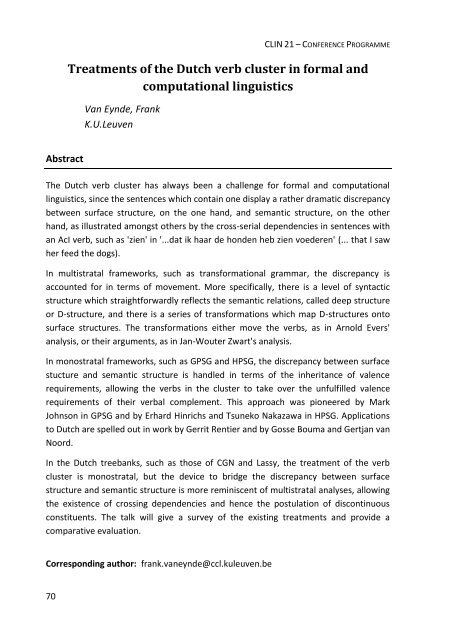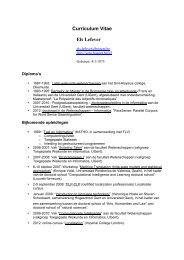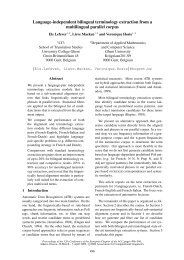Programme booklet (pdf)
Programme booklet (pdf)
Programme booklet (pdf)
Create successful ePaper yourself
Turn your PDF publications into a flip-book with our unique Google optimized e-Paper software.
Abstract<br />
70<br />
CLIN 21 – CONFERENCE PROGRAMME<br />
Treatments of the Dutch verb cluster in formal and<br />
computational linguistics<br />
Van Eynde, Frank<br />
K.U.Leuven<br />
The Dutch verb cluster has always been a challenge for formal and computational<br />
linguistics, since the sentences which contain one display a rather dramatic discrepancy<br />
between surface structure, on the one hand, and semantic structure, on the other<br />
hand, as illustrated amongst others by the cross-serial dependencies in sentences with<br />
an AcI verb, such as 'zien' in '...dat ik haar de honden heb zien voederen' (... that I saw<br />
her feed the dogs).<br />
In multistratal frameworks, such as transformational grammar, the discrepancy is<br />
accounted for in terms of movement. More specifically, there is a level of syntactic<br />
structure which straightforwardly reflects the semantic relations, called deep structure<br />
or D-structure, and there is a series of transformations which map D-structures onto<br />
surface structures. The transformations either move the verbs, as in Arnold Evers'<br />
analysis, or their arguments, as in Jan-Wouter Zwart's analysis.<br />
In monostratal frameworks, such as GPSG and HPSG, the discrepancy between surface<br />
stucture and semantic structure is handled in terms of the inheritance of valence<br />
requirements, allowing the verbs in the cluster to take over the unfulfilled valence<br />
requirements of their verbal complement. This approach was pioneered by Mark<br />
Johnson in GPSG and by Erhard Hinrichs and Tsuneko Nakazawa in HPSG. Applications<br />
to Dutch are spelled out in work by Gerrit Rentier and by Gosse Bouma and Gertjan van<br />
Noord.<br />
In the Dutch treebanks, such as those of CGN and Lassy, the treatment of the verb<br />
cluster is monostratal, but the device to bridge the discrepancy between surface<br />
structure and semantic structure is more reminiscent of multistratal analyses, allowing<br />
the existence of crossing dependencies and hence the postulation of discontinuous<br />
constituents. The talk will give a survey of the existing treatments and provide a<br />
comparative evaluation.<br />
Corresponding author: frank.vaneynde@ccl.kuleuven.be




